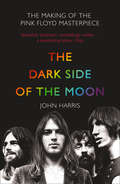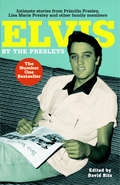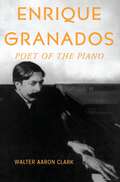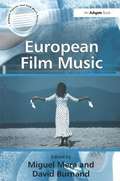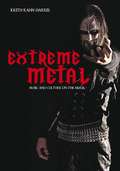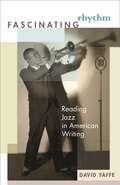- Table View
- List View
Damage Incorporated: Metallica and the Production of Musical Identity
by Glenn Pillsbury"Damage Incorporated" is the first book about the legendary heavy metal band Metallica that provides a detailed exploration of the group’s music and its place within the wider popular music landscape. Written with a broad readership in mind, it offers an interdisciplinary study that incorporates a range of topics which intersect with the band’s music and cultural influence. For students of popular culture, mass media, and music, "Damage Incorporated" will be necessary reading, and sets a new standard for the study and exploration of metal within the field of popular music studies.
The Dark Side of the Moon: The Making Of The Pink Floyd Masterpiece
by John HarrisA behind-the-scenes, in-depth look at the making of one of the greatest sonic masterpieces and most commercially successful albums of all time.
Divas and Scholars: Performing Italian Opera
by Philip GossettWinner of the 2007 Otto Kinkeldey Award from the American Musicological Society and the 2007 Deems Taylor Award from the American Society of Composers, Authors, and Publishers. Divas and Scholars is a dazzling and beguiling account of how opera comes to the stage, filled with Philip Gossett’s personal experiences of triumphant—and even failed—performances and suffused with his towering and tonic passion for music. Writing as a fan, a musician, and a scholar, Gossett, the world's leading authority on the performance of Italian opera, brings colorfully to life the problems, and occasionally the scandals, that attend the production of some of our most favorite operas. Gossett begins by tracing the social history of nineteenth-century Italian theaters in order to explain the nature of the musical scores from which performers have long worked. He then illuminates the often hidden but crucial negotiations opera scholars and opera conductors and performers: What does it mean to talk about performing from a critical edition? How does one determine what music to perform when multiple versions of an opera exist? What are the implications of omitting passages from an opera in a performance? In addition to vexing questions such as these, Gossett also tackles issues of ornamentation and transposition in vocal style, the matters of translation and adaptation, and even aspects of stage direction and set design. Throughout this extensive and passionate work, Gossett enlivens his history with reports from his own experiences with major opera companies at venues ranging from the Metropolitan and Santa Fe operas to the Rossini Opera Festival at Pesaro. The result is a book that will enthrall both aficionados of Italian opera and newcomers seeking a reliable introduction to it—in all its incomparable grandeur and timeless allure.
Divas and Scholars: Performing Italian Opera
by Philip GossettWinner of the 2007 Otto Kinkeldey Award from the American Musicological Society and the 2007 Deems Taylor Award from the American Society of Composers, Authors, and Publishers. Divas and Scholars is a dazzling and beguiling account of how opera comes to the stage, filled with Philip Gossett’s personal experiences of triumphant—and even failed—performances and suffused with his towering and tonic passion for music. Writing as a fan, a musician, and a scholar, Gossett, the world's leading authority on the performance of Italian opera, brings colorfully to life the problems, and occasionally the scandals, that attend the production of some of our most favorite operas. Gossett begins by tracing the social history of nineteenth-century Italian theaters in order to explain the nature of the musical scores from which performers have long worked. He then illuminates the often hidden but crucial negotiations opera scholars and opera conductors and performers: What does it mean to talk about performing from a critical edition? How does one determine what music to perform when multiple versions of an opera exist? What are the implications of omitting passages from an opera in a performance? In addition to vexing questions such as these, Gossett also tackles issues of ornamentation and transposition in vocal style, the matters of translation and adaptation, and even aspects of stage direction and set design. Throughout this extensive and passionate work, Gossett enlivens his history with reports from his own experiences with major opera companies at venues ranging from the Metropolitan and Santa Fe operas to the Rossini Opera Festival at Pesaro. The result is a book that will enthrall both aficionados of Italian opera and newcomers seeking a reliable introduction to it—in all its incomparable grandeur and timeless allure.
Divas and Scholars: Performing Italian Opera
by Philip GossettWinner of the 2007 Otto Kinkeldey Award from the American Musicological Society and the 2007 Deems Taylor Award from the American Society of Composers, Authors, and Publishers. Divas and Scholars is a dazzling and beguiling account of how opera comes to the stage, filled with Philip Gossett’s personal experiences of triumphant—and even failed—performances and suffused with his towering and tonic passion for music. Writing as a fan, a musician, and a scholar, Gossett, the world's leading authority on the performance of Italian opera, brings colorfully to life the problems, and occasionally the scandals, that attend the production of some of our most favorite operas. Gossett begins by tracing the social history of nineteenth-century Italian theaters in order to explain the nature of the musical scores from which performers have long worked. He then illuminates the often hidden but crucial negotiations opera scholars and opera conductors and performers: What does it mean to talk about performing from a critical edition? How does one determine what music to perform when multiple versions of an opera exist? What are the implications of omitting passages from an opera in a performance? In addition to vexing questions such as these, Gossett also tackles issues of ornamentation and transposition in vocal style, the matters of translation and adaptation, and even aspects of stage direction and set design. Throughout this extensive and passionate work, Gossett enlivens his history with reports from his own experiences with major opera companies at venues ranging from the Metropolitan and Santa Fe operas to the Rossini Opera Festival at Pesaro. The result is a book that will enthrall both aficionados of Italian opera and newcomers seeking a reliable introduction to it—in all its incomparable grandeur and timeless allure.
Divas and Scholars: Performing Italian Opera
by Philip GossettWinner of the 2007 Otto Kinkeldey Award from the American Musicological Society and the 2007 Deems Taylor Award from the American Society of Composers, Authors, and Publishers. Divas and Scholars is a dazzling and beguiling account of how opera comes to the stage, filled with Philip Gossett’s personal experiences of triumphant—and even failed—performances and suffused with his towering and tonic passion for music. Writing as a fan, a musician, and a scholar, Gossett, the world's leading authority on the performance of Italian opera, brings colorfully to life the problems, and occasionally the scandals, that attend the production of some of our most favorite operas. Gossett begins by tracing the social history of nineteenth-century Italian theaters in order to explain the nature of the musical scores from which performers have long worked. He then illuminates the often hidden but crucial negotiations opera scholars and opera conductors and performers: What does it mean to talk about performing from a critical edition? How does one determine what music to perform when multiple versions of an opera exist? What are the implications of omitting passages from an opera in a performance? In addition to vexing questions such as these, Gossett also tackles issues of ornamentation and transposition in vocal style, the matters of translation and adaptation, and even aspects of stage direction and set design. Throughout this extensive and passionate work, Gossett enlivens his history with reports from his own experiences with major opera companies at venues ranging from the Metropolitan and Santa Fe operas to the Rossini Opera Festival at Pesaro. The result is a book that will enthrall both aficionados of Italian opera and newcomers seeking a reliable introduction to it—in all its incomparable grandeur and timeless allure.
Divas and Scholars: Performing Italian Opera
by Philip GossettWinner of the 2007 Otto Kinkeldey Award from the American Musicological Society and the 2007 Deems Taylor Award from the American Society of Composers, Authors, and Publishers. Divas and Scholars is a dazzling and beguiling account of how opera comes to the stage, filled with Philip Gossett’s personal experiences of triumphant—and even failed—performances and suffused with his towering and tonic passion for music. Writing as a fan, a musician, and a scholar, Gossett, the world's leading authority on the performance of Italian opera, brings colorfully to life the problems, and occasionally the scandals, that attend the production of some of our most favorite operas. Gossett begins by tracing the social history of nineteenth-century Italian theaters in order to explain the nature of the musical scores from which performers have long worked. He then illuminates the often hidden but crucial negotiations opera scholars and opera conductors and performers: What does it mean to talk about performing from a critical edition? How does one determine what music to perform when multiple versions of an opera exist? What are the implications of omitting passages from an opera in a performance? In addition to vexing questions such as these, Gossett also tackles issues of ornamentation and transposition in vocal style, the matters of translation and adaptation, and even aspects of stage direction and set design. Throughout this extensive and passionate work, Gossett enlivens his history with reports from his own experiences with major opera companies at venues ranging from the Metropolitan and Santa Fe operas to the Rossini Opera Festival at Pesaro. The result is a book that will enthrall both aficionados of Italian opera and newcomers seeking a reliable introduction to it—in all its incomparable grandeur and timeless allure.
Divas and Scholars: Performing Italian Opera
by Philip GossettWinner of the 2007 Otto Kinkeldey Award from the American Musicological Society and the 2007 Deems Taylor Award from the American Society of Composers, Authors, and Publishers. Divas and Scholars is a dazzling and beguiling account of how opera comes to the stage, filled with Philip Gossett’s personal experiences of triumphant—and even failed—performances and suffused with his towering and tonic passion for music. Writing as a fan, a musician, and a scholar, Gossett, the world's leading authority on the performance of Italian opera, brings colorfully to life the problems, and occasionally the scandals, that attend the production of some of our most favorite operas. Gossett begins by tracing the social history of nineteenth-century Italian theaters in order to explain the nature of the musical scores from which performers have long worked. He then illuminates the often hidden but crucial negotiations opera scholars and opera conductors and performers: What does it mean to talk about performing from a critical edition? How does one determine what music to perform when multiple versions of an opera exist? What are the implications of omitting passages from an opera in a performance? In addition to vexing questions such as these, Gossett also tackles issues of ornamentation and transposition in vocal style, the matters of translation and adaptation, and even aspects of stage direction and set design. Throughout this extensive and passionate work, Gossett enlivens his history with reports from his own experiences with major opera companies at venues ranging from the Metropolitan and Santa Fe operas to the Rossini Opera Festival at Pesaro. The result is a book that will enthrall both aficionados of Italian opera and newcomers seeking a reliable introduction to it—in all its incomparable grandeur and timeless allure.
DJing for Dummies
by John SteventonFrom novice to nightclub -- without the nightmares. Whether you're a bedroom DJ looking to improve, or an accomplished amateur making the transition to playing live, DJing For Dummies has the accessible information you need. From what to buy (and what not to buy), mastering the beat, and reading a crowd, to all the tricks, techniques, and flourishes of a pro DJ, you'll be turning noise into notoriety in no time. Discover how to: * Buy the essential equipment * Set up your kit * beatmatch seamlessly * scratch with vinyl and CD * make a great demo * Market yourself as a DJ * Explanations in plain English ' * Get in get out' information * Icons and other navigational aids * Tear-out cheat sheet * Top ten lists * A dash of humour and fun Get Smart!@www.dummies.com * Find listings of all our books * Choose from many different subject categories * Browse out free articles
Drums For Dummies
by Jeff StrongGet down with rock, R&B, jazz, blues, funk, and Latin rhythms! Groove to the beat in no time with this ultimate rockin' guide! Whether you're dreaming of starting a band, striking the snares, or simply playing a hand drum, this interactive book-and-CD package makes it easy to pick up the basics. Complete with new information on contemporary rock styles and beats as well as rhythms from around the world, this guide is all you need to become a talented, versatile drummer. Discover how to Bang out basic rhythms --with or without sticks Understand fundamental drumming techniques Explore other percussion instruments Find the perfect drum set Purchase, tune, and maintain your drums All this on the CD-ROM MP3 files of each rhythm and beat that you can play along with Rhythms for hand drums -- from the bongos and congas to the surdo, tar, and udu Solos to amaze the other members in the band Note: CD-ROM/DVD and other supplementary materials are not included as part of eBook file.
Drums For Dummies
by Jeff StrongGet down with rock, R&B, jazz, blues, funk, and Latin rhythms! Groove to the beat in no time with this ultimate rockin' guide! Whether you're dreaming of starting a band, striking the snares, or simply playing a hand drum, this interactive book-and-CD package makes it easy to pick up the basics. Complete with new information on contemporary rock styles and beats as well as rhythms from around the world, this guide is all you need to become a talented, versatile drummer. Discover how to Bang out basic rhythms --with or without sticks Understand fundamental drumming techniques Explore other percussion instruments Find the perfect drum set Purchase, tune, and maintain your drums All this on the CD-ROM MP3 files of each rhythm and beat that you can play along with Rhythms for hand drums -- from the bongos and congas to the surdo, tar, and udu Solos to amaze the other members in the band Note: CD-ROM/DVD and other supplementary materials are not included as part of eBook file.
Elements of Sonata Theory: Norms, Types, and Deformations in the Late-Eighteenth-Century Sonata
by James Hepokoski Warren DarcyElements of Sonata Theory is a comprehensive, richly detailed rethinking of the basic principles of sonata form in the decades around 1800. This foundational study draws upon the joint strengths of current music history and music theory to outline a new, up-to-date paradigm for understanding the compositional choices found in the instrumental works of Haydn, Mozart, Beethoven, and their contemporaries: sonatas, chamber music, symphonies, overtures, and concertos. In so doing, it also lays out the indispensable groundwork for anyone wishing to confront the later adaptations and deformations of these basic structures in the nineteenth and earlier twentieth centuries. Combining insightful music analysis, contemporary genre theory, and provocative hermeneutic turns, the book brims over with original ideas, bold and fresh ways of awakening the potential meanings within a familiar musical repertory. Sonata Theory grasps individual compositions-and each of the individual moments within them-as creative dialogues with an implicit conceptual background of flexible, ever-changing historical norms and patterns. These norms may be recreated as constellations "compositional defaults," any of which, however, may be stretched, strained, or overridden altogether for individualized structural or expressive purposes. This book maps out the terrain of that conceptual background, against which what actually happens-or does not happen-in any given piece may be assessed and measured. The Elements guides the reader through the standard (and less-than-standard) formatting possibilities within each compositional space in sonata form, while also emphasizing the fundamental role played by processes of large-scale circularity, or "rotation," in the crucially important ordering of musical modules over an entire movement. The book also illuminates new ways of understanding codas and introductions, of confronting the generating processes of minor-mode sonatas, and of grasping the arcs of multimovement cycles as wholes. Its final chapters provide individual studies of alternative sonata types, including "binary" sonata structures, sonata-rondos, and the "first-movement form" of Mozart's concertos.
Elvis by the Presleys
by The PresleysThe Number One Sunday Times BestsellerForty years after his death, Elvis Presley remains one of the world's most beloved and iconic figures. There has been an impressive array of bestselling Elvis books over the years, but there has never been a book like this. Now, for the first time, Elvis, the man, husband father and artist, is remembered intimately and honestly by his ex wife Priscilla, daughter Lisa Marie and other close family members. Including deeply personal documents and previously unseen family photographs, this sensational book also features new interviews with family and friends. From personal diary entries to unearthed artefacts, Elvis by the Presleys is a publishing phenomenon and comes closer than any other book in revealing the private dreams and truths of the extraordinary and complex man, who became the king of Rock and Roll.
Emblems of Mind: The Inner Life of Music and Mathematics
by Edward RothsteinOne is a science, the other an art; one useful, the other seemingly decorative, but mathematics and music share common origins in cult and mystery and have been linked throughout history. Emblems of Mind is Edward Rothstein’s classic exploration of their profound similarities, a journey into their “inner life.” Along the way, Rothstein explains how mathematics makes sense of space, how music tells a story, how theories are constructed, how melody is shaped. He invokes the poetry of Wordsworth, the anthropology of Lévi-Strauss, the imagery of Plato, and the philosophy of Kant. Math and music, Rothstein shows, apply comparable methods as they create their abstractions, display similar concerns with ratio and proportion, and depend on metaphors and analogies to create their meanings. Ultimately, Rothstein argues, they reveal the ways in which we come to understand the world. They are images of the mind at work and play; indeed, they are emblems of Mind itself. Jacques Barzun called this book “splendid.” Martin Gardner said it was “beautifully written, marvelous and entertaining.” It will provoke all serious readers to think in new ways about the grand patterns in art and life. “Lovely, wistful. . . . Rothstein is a wonderful guide to the architecture of musical space, its tensions and relations, its resonances and proportions. . . . His account of what is going on in the music is unfailingly felicitous.”—New Yorker “Provocative and exciting. . . . Rothstein writes this book as a foreign correspondent, sending dispatches from a remote and mysterious locale as a guide for the intellectually adventurous. The remarkable fact about his work is not that it is profound, as much of the writing is, but that it is so accessible.”—Christian Science Monitor
Enrique Granados: Poet of the Piano
by Walter Aaron ClarkEnrique Granados (1867-1916) is one of the most compelling figures of the late-Romantic period in music. During his return voyage to Spain after the premiere of his opera Goyescas at New York's Metropolitan Opera in 1916, a German submarine torpedoed the ship on which he and his wife were sailing, and they perished in the waters of the English Channel. His death was mourned on both sides of the Atlantic as a stunning loss to the music world, for he had died at the pinnacle of his career, and his late works held the promise of greater things to come. Granados was among the leading pianists of his time, and his eloquence at the keyboard inspired critics to dub him the "poet of the piano." In Enrique Granados: Poet of the Piano, Walter Aaron Clark offers the first substantive study in English of this virtuoso pianist, composer, and music pedagogue. While providing detailed analyses of his major works for voice, piano, and the stage, Clark argues that Granados's art represented a unifying presence on the cultural landscape of Spain during a period of imperial decline, political unrest, and economic transformation. Drawing on newly discovered documents, Clark explores the cultural spheres in which Granados moved, particularly of Castile and Catalonia. Granados's best-known music was inspired by the art of Francisco Goya, especially the Goyescas suite for solo piano that became the basis for the opera. These pieces evoked the colorful and dramatic world that Goya inhabited and depicted in his art. Granados's fascination with Goya's Madrid set him apart from fellow nationalists Albéniz and Falla, who drew their principal inspiration from Andalusia. Though he was resolutely apolitical, Granados's attraction to Castile antagonized some Catalan nationalists, who resented Castilian domination. Yet Granados also made important contributions to Catalan musical theater and was a prominent figure in the modernist movement in Barcelona. Clark also explores the personal pressures that shaped Granados's music. His passionate affair with a wealthy socialite created domestic tensions, but it was also a source of inspiration for Goyescas. Persistent financial difficulties forced him to devote time to teaching at the expense of composition, though as a result Granados made considerable contributions to piano pedagogy and music education in Barcelona through the music academy he founded there. While Granados's tragic and early demise casts a pall over his life story, Clark ultimately reveals an artist of remarkable versatility and individuality and sheds new light on his enduring significance.
The Ethnomusicologists' Cookbook: Complete Meals from Around the World
by Sean WilliamsNamed one of New York Times Top-20 Cookbooks of 2006. Have you ever wanted to host a full evening of Indian food, culture, and music? How about preparing a traditional Balinese banquet? Or take a trip to Cairo and enjoy an Egyptian feast? The Ethnomusicologists' Cookbook takes you around the world on a culinary journey that is also a cultural and social odyssey. Many cookbooks offer a snapshot of individual recipes from different parts of the world, but do nothing to tell the reader how different foods are presented together, or how to relate these foods to other cultural practices. For years, ethnomusicologists have visited the four corners of the earth to collect the music and culture of native peoples, from Africa to the Azores, from Zanzibar to New Zealand. Along the way, they've observed how music is an integral part of social interaction, particularly when it's time for a lavish banquet or celebration. Foodways and cultural expression are not separate; this book emphasizes this connection through offering over thirty-five complete meals, from appetizers to entrees to side dishes to desserts and drinks. A list of recommended CDs fills out the culinary experience, along with hints on how to present each dish and to organize the overall meal. The Ethnomusicologists' Cookbook combines scholarship with a unique and fun approach to the study of the world's foods, musics, and cultures. More than just a cookbook, it is an excellent companion for anyone embarking on a cultural-culinary journey.
The Ethnomusicologists' Cookbook: Complete Meals from Around the World
by Sean WilliamsNamed one of New York Times Top-20 Cookbooks of 2006. Have you ever wanted to host a full evening of Indian food, culture, and music? How about preparing a traditional Balinese banquet? Or take a trip to Cairo and enjoy an Egyptian feast? The Ethnomusicologists' Cookbook takes you around the world on a culinary journey that is also a cultural and social odyssey. Many cookbooks offer a snapshot of individual recipes from different parts of the world, but do nothing to tell the reader how different foods are presented together, or how to relate these foods to other cultural practices. For years, ethnomusicologists have visited the four corners of the earth to collect the music and culture of native peoples, from Africa to the Azores, from Zanzibar to New Zealand. Along the way, they've observed how music is an integral part of social interaction, particularly when it's time for a lavish banquet or celebration. Foodways and cultural expression are not separate; this book emphasizes this connection through offering over thirty-five complete meals, from appetizers to entrees to side dishes to desserts and drinks. A list of recommended CDs fills out the culinary experience, along with hints on how to present each dish and to organize the overall meal. The Ethnomusicologists' Cookbook combines scholarship with a unique and fun approach to the study of the world's foods, musics, and cultures. More than just a cookbook, it is an excellent companion for anyone embarking on a cultural-culinary journey.
Ethnomusicology: A Contemporary Reader
by Jennifer C. PostEthnomusicology: A Contemporary Reader is designed to supplement a textbook for an introductory course in ethnomusicology. It offers a cross section of the best new writing in the field from the last 15-20 years. Many instructors supplement textbook readings and listening assignments with scholarly articles that provide more in-depth information on geographic regions and topics and introduce issues that can facilitate class or small group discussion. These sources serve other purposes as well: they exemplify research technique and format and serve as models for the use of academic language, and collectively they can also illustrate the range of ethnographic method and analytical style in the discipline of ethnomusicology. Ethnomusicology: A Contemporary Reader serves as a basic introduction to the best writing in the field for students, professors, and music professionals. It is perfect for both introductory and upper level courses in world music.
Ethnomusicology: A Contemporary Reader (Routledge Music Bibliographies Ser.)
by Jennifer C. PostEthnomusicology: A Contemporary Reader is designed to supplement a textbook for an introductory course in ethnomusicology. It offers a cross section of the best new writing in the field from the last 15-20 years. Many instructors supplement textbook readings and listening assignments with scholarly articles that provide more in-depth information on geographic regions and topics and introduce issues that can facilitate class or small group discussion. These sources serve other purposes as well: they exemplify research technique and format and serve as models for the use of academic language, and collectively they can also illustrate the range of ethnographic method and analytical style in the discipline of ethnomusicology. Ethnomusicology: A Contemporary Reader serves as a basic introduction to the best writing in the field for students, professors, and music professionals. It is perfect for both introductory and upper level courses in world music.
Europe, Empire, and Spectacle in Nineteenth-Century British Music
by Julian RushtonThis volume illuminates musical connections between Britain and the continent of Europe, and Britain and its Empire. The seldom-recognized vitality of musical theatre and other kinds of spectacle in Britain itself, and also the flourishing concert life of the period, indicates a means of defining tradition and identity within nineteenth-century British musical culture. The objective of the volume has been to add significantly to the growing literature on these topics. It benefits not only from new archival research, but also from fresh musicological approaches and interdisciplinary methods that recognize the integral role of music within a wider culture, including religious, political and social life. The essays are by scholars from the USA, Britain, and Europe, covering a wide range of experience. Topics range from the reception of Bach, Mozart, and Liszt in England, a musical response to Shakespeare, Italian opera in Dublin, exoticism, gender, black musical identities, British musicians in Canada, and uses of music in various theatrical genres and state ceremony, and in articulating the politics of the Union and Empire.
Europe, Empire, and Spectacle in Nineteenth-Century British Music
by Julian RushtonThis volume illuminates musical connections between Britain and the continent of Europe, and Britain and its Empire. The seldom-recognized vitality of musical theatre and other kinds of spectacle in Britain itself, and also the flourishing concert life of the period, indicates a means of defining tradition and identity within nineteenth-century British musical culture. The objective of the volume has been to add significantly to the growing literature on these topics. It benefits not only from new archival research, but also from fresh musicological approaches and interdisciplinary methods that recognize the integral role of music within a wider culture, including religious, political and social life. The essays are by scholars from the USA, Britain, and Europe, covering a wide range of experience. Topics range from the reception of Bach, Mozart, and Liszt in England, a musical response to Shakespeare, Italian opera in Dublin, exoticism, gender, black musical identities, British musicians in Canada, and uses of music in various theatrical genres and state ceremony, and in articulating the politics of the Union and Empire.
European Film Music (PDF)
by Miguel Mera David BurnandThe vast majority of writing on film music is concentrated on Hollywood in particular and on a canon of North American scores and films more generally. Recent scholarship acknowledges other traditions of film scoring but little has been written about European film music specifically. Miguel Mera and David Burnand present a volume that redresses the balance by exploring specific European filmic texts, composers and approaches to film scoring that have hitherto been neglected. Films involving British, French, German, Greek, Irish, Italian, Polish and Spanish composers are considered in detail. Starting from a study of the influence of propaganda on musical aesthetics in Nazi Germany the book includes an analysis of Italian neo-realist cinema, a consideration of the Ealing Comedies, experimental music in contemporary Spanish scoring, the invocation of traditional music, the portrayal of classical music performers, the use of space, silence and manipulation of time, and the depiction of the processes of scoring in independent film-making. Important issues that permeate all the essays involve the working relationship of composer and director, the dialectic between the diegetic and non-diegetic uses of music in films, the music-image synergism and the levels of realism that are created by the audio-visual mix. The book will appeal to those working in film studies, popular music studies, musicology, media studies and cultural theory.
Extreme Metal: Music and Culture on the Edge
by Keith Kahn-HarrisExtreme metal--one step beyond heavy metal--can appear bizarre or terrifying to the uninitiated. Extreme metal musicians have developed an often impenetrable sound that teeters on the edge of screaming, incomprehensible noise. Extreme metal circulates on the edge of mainstream culture within the confines of an obscure 'scene', in which members explore dangerous themes such as death, war and the occult, sometimes embracing violence, neo-fascism and Satanism. In the first book-length study of extreme metal, Keith Kahn-Harris draws on first-hand research to explore the global extreme metal scene. He shows how the scene is a space in which members creatively explore destructive themes, but also a space in which members experience the everyday pleasures of community and friendship.Including interviews with band members and fans, from countries ranging from the UK and US to Israel and Sweden, Extreme Metal: Music and Culture on the Edge demonstrates the power and subtlety of an often surprising and misunderstood musical form.
Fascinating Rhythm: Reading Jazz in American Writing
by David YaffeHow have American writers written about jazz, and how has jazz influenced American literature? In Fascinating Rhythm, David Yaffe explores the relationship and interplay between jazz and literature, looking at jazz musicians and the themes literature has garnered from them by appropriating the style, tones, and innovations of jazz, and demonstrating that the poetics of jazz has both been assimilated into, and deeply affected, the development of twentieth-century American literature. Yaffe explores how Jewish novelists such as Norman Mailer, J. D. Salinger, and Philip Roth engaged issues of racial, ethnic, and American authenticity by way of jazz; how Ralph Ellison's descriptions of Louis Armstrong led to a "neoconservative" movement in contemporary jazz; how poets such as Wallace Stevens, Hart Crane, Langston Hughes, and Frank O'Hara were variously inspired by the music; and how memoirs by Billie Holiday, Charles Mingus, and Miles Davis both reinforced and redeemed the red light origins of jazz. The book confronts the current jazz discourse and shows how poets and novelists can be placed in it--often with problematic results. Fascinating Rhythm stops to listen for the music, demonstrating how jazz continues to speak for the American writer.
Fascinating Rhythm: Reading Jazz in American Writing
by David YaffeHow have American writers written about jazz, and how has jazz influenced American literature? In Fascinating Rhythm, David Yaffe explores the relationship and interplay between jazz and literature, looking at jazz musicians and the themes literature has garnered from them by appropriating the style, tones, and innovations of jazz, and demonstrating that the poetics of jazz has both been assimilated into, and deeply affected, the development of twentieth-century American literature. Yaffe explores how Jewish novelists such as Norman Mailer, J. D. Salinger, and Philip Roth engaged issues of racial, ethnic, and American authenticity by way of jazz; how Ralph Ellison's descriptions of Louis Armstrong led to a "neoconservative" movement in contemporary jazz; how poets such as Wallace Stevens, Hart Crane, Langston Hughes, and Frank O'Hara were variously inspired by the music; and how memoirs by Billie Holiday, Charles Mingus, and Miles Davis both reinforced and redeemed the red light origins of jazz. The book confronts the current jazz discourse and shows how poets and novelists can be placed in it--often with problematic results. Fascinating Rhythm stops to listen for the music, demonstrating how jazz continues to speak for the American writer.

